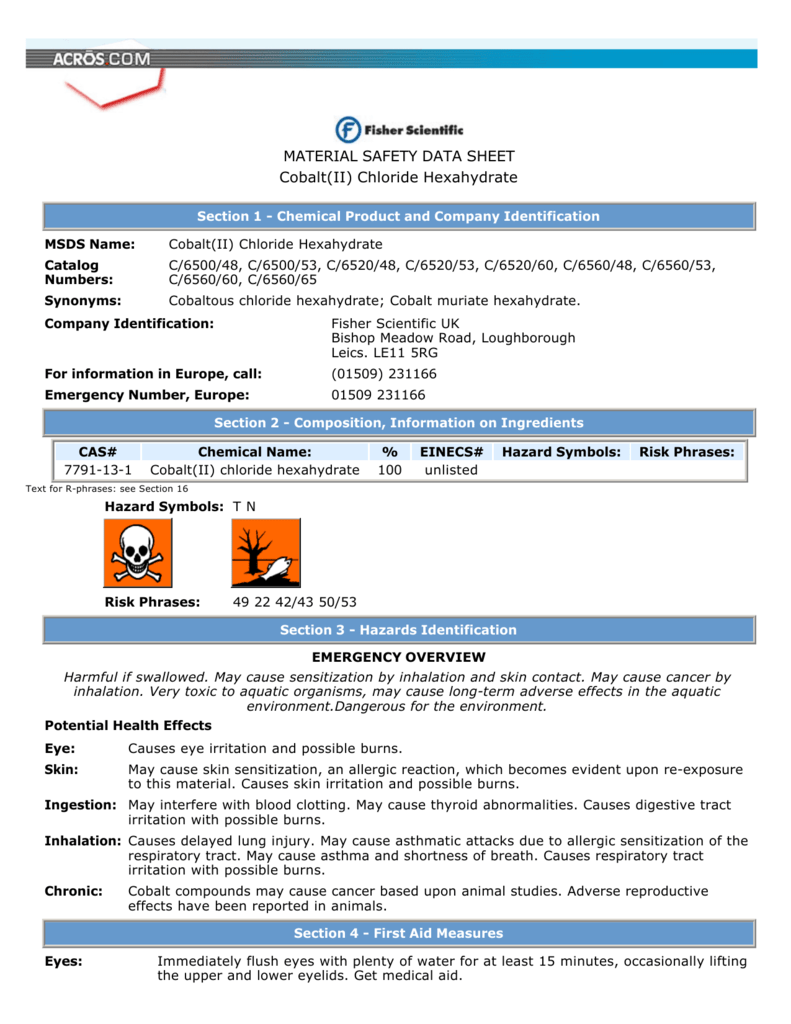

Rest and medical observation are therefore essential.ĭepending on the degree of exposure, periodic medical examination is suggested. The symptoms of asthma often do not become manifest until a few hours have passed and they are aggravated by physical effort. It is strongly advised not to let the chemical enter into the environment.Īnyone who has shown symptoms of asthma due to this substance should avoid all further contact. The substance may cause long-term effects in the aquatic environment. The substance is very toxic to aquatic organisms.
#Cobalt ii chloride skin
MAK: (as Co, inhalable fraction): skin absorption (H) sensitization of respiratory tract and skin (SAH) carcinogen category: 2 germ cell mutagen group: 3A TLV: (as Co, inhalable fraction): 0.02 mg/m 3, as TWA (DSEN) (RSEN) A3 (confirmed animal carcinogen with unknown relevance to humans) BEI issued.

Animal tests show that this substance possibly causes toxic effects upon human reproduction. This substance is possibly carcinogenic to humans. Ingestion may cause effects on the heart, bone marrow and thyroid. Repeated or prolonged inhalation may cause asthma. Repeated or prolonged contact may cause skin sensitization. The substance can be absorbed into the body by inhalation and by ingestion.Ī harmful concentration of airborne particles can be reached quickly when dispersed.Įffects of long-term or repeated exposure Octanol/water partition coefficient as log Pow: 0.85 Solubility in water, g/100ml at 20☌: 53 (good) TURNS PINK ON EXPOSURE TO AIR AND MOISTURE. With the financial assistance of the European Commission. Prepared by an international group of experts on behalf of ILO and WHO, Provision to contain effluent from fire extinguishing.ĭo not transport with food and feedstuffs. Store in an area without drain or sewer access. Separated from oxidants and food and feedstuffs. Very toxic to aquatic life with long lasting effectsĭry. May cause damage to thyroid, bone marrow and heart through prolonged or repeated exposure if swallowed May cause allergy or asthma symptoms or breathing difficulties if inhaled Then store and dispose of according to local regulations. If appropriate, moisten first to prevent dusting. Sweep spilled substance into covered containers. Do NOT let this chemical enter the environment. Personal protection: particulate filter respirator adapted to the airborne concentration of the substance. Give one or two glasses of water to drink. Vomiting.ĭo not eat, drink, or smoke during work. Wear safety goggles or eye protection in combination with breathing protection.įirst rinse with plenty of water for several minutes (remove contact lenses if easily possible), then refer for medical attention.Ībdominal pain. Rinse skin with plenty of water or shower. Use local exhaust or breathing protection.įresh air, rest. PREVENT DISPERSION OF DUST! AVOID ALL CONTACT! In case of fire in the surroundings, use appropriate extinguishing media. Gives off irritating or toxic fumes (or gases) in a fire. Other heavy metals should be collected separately.Not combustible. to AbfallverzeichnisV - Waste Catalogue Ordinance, Appendix 3). In this context, heavy metal means any compound of antimony, arsenic, cadmium, chromium(VI), copper, lead, nickel and tin, as well as these subtances in metallic form, if they are classified as hazardous (acc. Neither Raney nickel itself nor any filter residues should be allowed to dry out, otherwise they will spontaneously ignite in air. Stir Raney nickel (also: Urushibara nickel) in the form of an aqueous suspension into hydrochloric acid (Cat. P308 + P313: IF exposed or concerned: Get medical advice/ attention.Ħ.1D Non-combustible, acute toxic Cat.3 / toxic hazardous materials or hazardous materials causing chronic effectsġ5 Heavy metal-containing solutions and solids: container E. Remove contact lenses, if present and easy to do. P305 + P351 + P338: IF IN EYES: Rinse cautiously with water for several minutes. P302 + P352: IF ON SKIN: Wash with plenty of water. P301 + P312: IF SWALLOWED: Call a POISON CENTER/doctor if you feel unwell. P280: Wear protective gloves/ protective clothing/ eye protection/ face protection/ hearing protection. H410: Very toxic to aquatic life with long lasting effects.

H341: Suspected of causing genetic defects. H334: May cause allergy or asthma symptoms or breathing difficulties if inhaled. H317: May cause an allergic skin reaction.


 0 kommentar(er)
0 kommentar(er)
